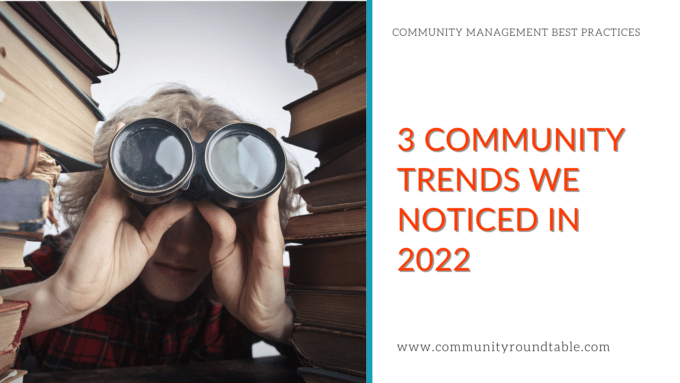We won’t give you another version of Spotify wrapped, but this is the time of year where one can’t help but reflect on what occurred in yet another historic year. What we’d like to share with you today are three community trends that we most look forward to exploring more of next year.

Community trend 1: Critical characteristics for community management
Teams are shifting, as are Community professionals. This year felt like the year of the year of extremes. In some cases the pandemic has highlighted the importance of Community in an organization. With that we’ve seen more C-Suite support and growing budgets. However, we can’t ignore the large layoffs in tech earlier this year and how that has real downstream effects on Community folks. We’ve seen a lot of folks make some big pivots this year. In some cases they are suddenly becoming team builders and people managers. In others, they are having to scramble and switch to an entirely new organization. That said, Community continues to trend towards becoming its own vertical. We’ve anecdotally seen more members looking for support on building teams. Contrasted to the last decade of Community Managers working as primarily solo practitioners, we count that as progress. We noticed many of these trends in 2021. They’ve only continued in 2022. Check out the State of Community Management 2022 for more.
Looking to brush up any of your community skills? Visit TheCR Academy to see our entire course catalog. Remember, complete access to all the courses is now available to all members of TheCR Network.
Trend 2: Say goodbye to the “90-9-1” rule
Gone are the days of the 90-9-1 ruling community management and social media (a.k.a. Participation inequality: 90% of participants are unengaged/inactive, 9% engage a little, 1% make up the majority of the content creation and engagement), and we have the research to back it up: the State of Community Management 2022. Instead, we would like to introduce you to the 20-25-55 rule.
- 20% of your members are actively creating content
- 25% are validating and consuming content (you may have heard them referred to as “lurkers,” but we find the term “learners” to be much more accurate in this context)
- 55% are inactive
Here in the Network, we have explored a model that dives into the strengths of digital fatigue; by breaking out less formal programming, we try to get members the value that most matters to them. Many of our peers expressed similar fatigue in their Communities- members want to connect and engage but also have competing needs for their attention. Even with digital fatigue, which we associate with the pandemic, we continue to see folks adopting remote opportunities to connect with their peers.
Community trend 3: The only consistent thing is change
The headline story this year in Community was about the unpredictability in the job market, with places like Meta and Twitter having record layoffs and restructuring. We saw this same trend across tech. A very illustrative visual courtesy of TrueUp.
Community is not immune to the changing landscape nor the continued whispers of a recession. No single post can encapsulate all that we can and want to say about those changes, however, we saw a number of our members pivot from unfavorable company dynamics and into better roles.
That shift and resulting uncertainty can be a trying time in anyone’s life. We recently hosted a panel about transitioning to new roles and the insights were invaluable.
Roundtable Call – When Growing Your Career Means Leaving your Community
A few gems from the call:
- Look beyond a title, and think holistically about what you want in a role.
- Another was around managing burnout. The panelists expressed how important it is to be analytical. And to be critical about what you actually want next rather than being in a reactionary state of being burned out.
- Focus on what you are running towards rather than what you’re running from. Where are your skills best applied?
As an offer to any reader who may be impacted by an unexpected job shift, we are currently offering our community fundamentals course for free. To take advantage of the program and possibly add to your community skills toolbox, send us a message and we’ll be happy to help you get started.
2022 was another year for the books and the Network. We appreciate all of you that have shown up, shared your thoughts, and hopefully learned alongside us at TheCR. We hope you have a restful, peaceful break and will see you in 2023.
